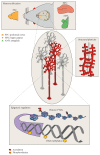Structural, Synaptic, and Epigenetic Dynamics of Enduring Memories
- PMID: 26933513
- PMCID: PMC4736770
- DOI: 10.1155/2016/3425908
Structural, Synaptic, and Epigenetic Dynamics of Enduring Memories
Abstract
Our memories are the records of the experiences we gain in our everyday life. Over time, they slowly transform from an initially unstable state into a long-lasting form. Many studies have been investigating from different aspects how a memory could persist for sometimes up to decades. In this review, we highlight three of the greatly addressed mechanisms that play a central role for a given memory to endure: the allocation of the memory to a given neuronal population and what brain areas are recruited for its storage; the structural changes that underlie memory persistence; and finally the epigenetic control of gene expression that might regulate and support memory perseverance. Examining such key properties of a memory is essential towards a finer understanding of its capacity to last.
Figures



References
-
- Semon R. Die Mneme als erhaltendes Prinzip im Wechsel des organischen Geschehens. Leipzig, Germany: Engelmann; 1904.
-
- Müller G. E., Pilzecker A. Experimentelle Beiträge zur Lehre vom Gedächtniss. Vol. 1. J. A. Barth; 1900.
-
- Lechner H. A., Squire L. R., Byrne J. H. 100 years of consolidation—remembering Müller and Pilzecker. Learning and Memory. 1999;6(2):77–87. - PubMed
Publication types
MeSH terms
LinkOut - more resources
Full Text Sources
Other Literature Sources
Medical

